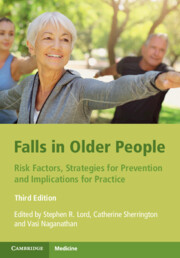Book contents
- Falls in Older People
- Falls in Older People
- Copyright page
- Contents
- Preface
- Contributors
- Part I Epidemiology and Risk Factors for Falls
- Part II Strategies for Prevention
- 16 Exercise to Prevent Falls
- 17 Volitional and Reactive Step Training
- 18 Cognitive-Motor Interventions and Their Effects on Fall Risk in Older People
- 19 Cognitive Behavioural Interventions for Addressing Fear of Falling and Fall Risk
- 20 The Medical Management of Older People at Risk of Falls
- 21 Fall Prevention Interventions for People with Visual Impairment
- 22 Footwear, Orthoses, Walking Aids, Wearable Technology, and Restraint Devices for Fall Prevention
- 23 Environmental Interventions to Prevent Falls at Home and in the Community
- 24 Fall Injury Prevention: Hip Protectors and Compliant Flooring
- 25 Multi-Factorial Fall Prevention Strategies: Where to Next?
- 26 Fall Prevention in Hospitals
- 27 Fall Prevention in Residential Aged Care Facilities
- Part III Implications for Practice
- Index
- References
24 - Fall Injury Prevention: Hip Protectors and Compliant Flooring
from Part II - Strategies for Prevention
Published online by Cambridge University Press: 04 November 2021
- Falls in Older People
- Falls in Older People
- Copyright page
- Contents
- Preface
- Contributors
- Part I Epidemiology and Risk Factors for Falls
- Part II Strategies for Prevention
- 16 Exercise to Prevent Falls
- 17 Volitional and Reactive Step Training
- 18 Cognitive-Motor Interventions and Their Effects on Fall Risk in Older People
- 19 Cognitive Behavioural Interventions for Addressing Fear of Falling and Fall Risk
- 20 The Medical Management of Older People at Risk of Falls
- 21 Fall Prevention Interventions for People with Visual Impairment
- 22 Footwear, Orthoses, Walking Aids, Wearable Technology, and Restraint Devices for Fall Prevention
- 23 Environmental Interventions to Prevent Falls at Home and in the Community
- 24 Fall Injury Prevention: Hip Protectors and Compliant Flooring
- 25 Multi-Factorial Fall Prevention Strategies: Where to Next?
- 26 Fall Prevention in Hospitals
- 27 Fall Prevention in Residential Aged Care Facilities
- Part III Implications for Practice
- Index
- References
Summary
This chapter reviews prevention from a different perspective. Instead of preventing the fall, this chapter examines fall injury prevention, a complementary approach that has a history of many decades. This approach has comprised two strategies. The first pertains to padding, or ‘protecting’ the hip or other body parts, including the head, while the second pertains to modifying the surface onto which the person falls to reduce fall impact. The main contrast between these approaches is that the use of body part protectors requires a commitment from the wearer or carers, whereas compliant flooring is a passive device requiring no such commitment or action.
- Type
- Chapter
- Information
- Falls in Older PeopleRisk Factors, Strategies for Prevention and Implications for Practice, pp. 378 - 385Publisher: Cambridge University PressPrint publication year: 2021
References
- 1
- Cited by



